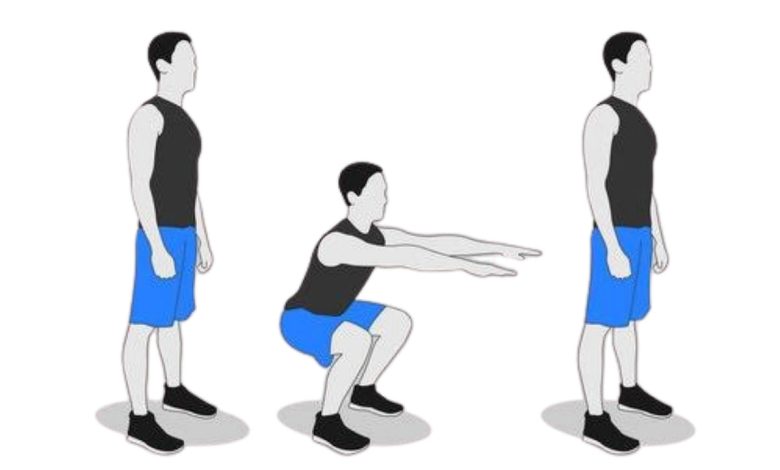Squat Exercise Benefits: A Cornerstone of Fitness

The squat, a simple yet incredibly effective exercise, has been a staple in fitness routines for centuries. It’s a compound movement that engages multiple muscle groups, making it a versatile and efficient way to improve strength, power, and overall athletic performance. In this comprehensive article, we’ll delve into the myriad benefits of the squat, exploring its impact on various aspects of health and fitness.
Understanding the Squat
Before we dive into the benefits, it’s essential to understand the mechanics of a proper squat. It primarily targets the quadriceps, hamstrings, glutes, and core muscles. When performed correctly, the squat involves:
Initiation: Begin by standing with your feet slightly wider than your shoulders, toes pointed slightly outward.
Descent: Lower your body as if sitting back into a chair, keeping your back straight and knees aligned with your toes.
Bottom Position: Squat until your thighs are parallel to the ground or slightly below, ensuring your heels remain on the floor.
Ascent: Push through your heels to return to the starting position, squeezing your glutes at the top.
The Benefits of Squat Exercise
The squat offers a plethora of benefits, making it a cornerstone of many fitness programs. Let’s explore some of the key advantages:
1.Increased Strength and Power
Compound Movement: The squat works multiple muscle groups simultaneously, leading to significant strength gains.
Core Engagement: It strengthens the core muscles, improving stability and overall athletic performance.
Power Development: Variations like jump squats can enhance explosive power, beneficial for athletes in sports requiring quick movements.
2.Improved Functional Fitness:
Daily Activities: Squats mimic everyday movements like sitting, standing, and climbing stairs, improving functional fitness.
Balance and Coordination: Regular squatting can enhance balance and coordination, reducing the risk of falls and injuries.
Posture: Strong leg muscles can help maintain proper posture and alignment.
3.Enhanced Athletic Performance:
Lower Body Power: Squats are essential for athletes in sports that require lower body power, such as running, jumping, and kicking.
Muscle Mass: Increased muscle mass from squatting can improve strength and speed.
Injury Prevention: Strong leg muscles can help prevent injuries, particularly in the knees and ankles.
4.Improved Cardiovascular Health:
Calorie Burn: Squats can be a great way to burn calories and support weight management.
Heart Health: Regular strength training, including squats, can improve heart health and reduce the risk of cardiovascular disease.
5.Boosted Metabolism:
Muscle Mass: Building muscle mass through squats can increase your resting metabolic rate, helping you burn more calories even at rest.
6.Enhanced Bone Density:
Weight-Bearing Exercise: Squats are a weight-bearing exercise that can help improve bone density, reducing the risk of osteoporosis.
7.Improved Flexibility:
Hip and Ankle Mobility: Squats can improve flexibility in the hips and ankles, enhancing overall mobility.
Variations of the Squat
To keep your workouts interesting and target different muscle groups, consider incorporating various squat variations:
- Barbell Back Squat: A classic variation that targets the quadriceps, hamstrings, and glutes.
- Goblet Squat: Holding a weight at your chest can help improve form and engage the core.
- Sumo Squat: A wider stance targets the inner thighs and glutes.
- Pistol Squat: A challenging single-leg variation that tests balance and strength.
- Box Squat: Using a box to sit back into can help improve depth and technique.
- Overhead Squat: A demanding variation that tests mobility and coordination.
Safety Considerations
While squats are generally safe, it’s essential to perform them with proper form to avoid injuries. Here are some safety tips:
Proper Form: Ensure your back remains straight, knees track over your toes, and your heels stay on the ground.
Weight Progression: Gradually increase the weight or resistance to avoid overloading your muscles.
Listen to Your Body: Pay attention to any pain or discomfort and adjust your workout accordingly.
Consult a Professional: If you have any concerns or injuries, consult a healthcare professional or certified personal trainer.
Incorporating Squats into Your Workout Routine
To maximize the benefits of squat exercise, consider incorporating them into your workout routine in the following ways:
Strength Training: Include squats as part of your lower body strength training routine, targeting different muscle groups with variations like barbell back squats, goblet squats, and sumo squats.
Plyometrics: Incorporate plyometric variations like jump squats and box jumps to improve explosive power and athletic performance.
Bodyweight Workouts: Use squats as a fundamental exercise in bodyweight workouts for a full-body challenge.
Functional Fitness: Integrate squats into functional fitness routines to improve everyday movements and coordination.
Squats for Different Fitness Levels
Squats can be adapted to suit individuals of all fitness levels:
Beginners: Start with bodyweight squats or use a light barbell or resistance band to gradually build strength.
Intermediate: Incorporate weighted squats, such as barbell back squats or goblet squats, with moderate weights.
Advanced: Experiment with more challenging variations like overhead squats and pistol squats, or increase the weight and intensity of your workouts.
Addressing Common Squat Mistakes
To ensure you’re getting the most out of your squats, be mindful of these common mistakes:
- Knee Valgus (Knee Collapse): Avoid letting your knees collapse inward during the squat. This can put stress on the joints and lead to injury.
- Rounded Back: Maintain a straight back throughout the movement to protect your spine.
- Heels Lifting: Ensure your heels remain on the ground to avoid shifting the load to your toes.
- Excessive Depth: While going deep in the squat is beneficial, avoid going too low if it causes pain or discomfort.
- Neglecting Mobility: Poor mobility in the hips, ankles, and shoulders can hinder proper squat form. Incorporate mobility drills to address these areas.
The Squat: A Lifelong Investment
The squat is a timeless exercise that offers numerous benefits for individuals of all ages and fitness levels. By understanding the proper form, incorporating squats into your workout routine, and addressing common mistakes, you can reap the rewards of this fundamental movement. The squat is not just an exercise; it’s an investment in your overall health and well-being.
Conclusion
The squat is a versatile and effective exercise that offers numerous benefits for individuals of all fitness levels. By incorporating squats into your workout routine, you can improve strength, power, functional fitness, and overall health. Remember to prioritize proper form, listen to your body, and consider incorporating variations to keep your workouts challenging and engaging.




